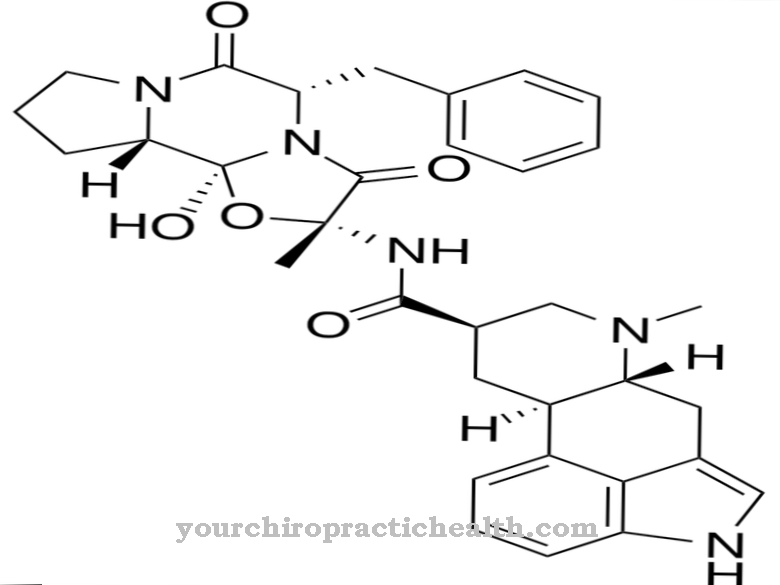Propafenone is a well-known active ingredient that is used to combat cardiac arrhythmias. Due to its chemical and pharmacological properties, propafenone is assigned to the class of antiarrhythmic drugs. The drug has been in use for several years and is considered very effective.
What is propafenone?
Propafenone is a well-known drug that is used to treat various cardiac arrhythmias. In Germany, Austria and Switzerland the drug is sold under the trade names Cuxafenon® and Prorynorm®.
There is an indication for tachyarrhythmia (cardiac arrhythmia that occurs in combination with a rapid heartbeat) as well as ventricular tachycardia (cardiac arrhythmia that coincides with an increased heart rate) and atrial fibrillation. It should be noted that the dose administered depends on the underlying disease requiring treatment.
In chemistry, propafenone is described by the empirical formula C 21 - H 27 - N - O 3. This corresponds to a moral mass of about 341.44 g / mol. Due to its chemical and pharmacological properties, propafenone is assigned to the group of so-called antiarrhythmics. These are not necessarily related substances that affect the heart rhythm.
In accordance with the classification according to E. Vaughan Williams in the medical and pharmacological literature, a distinction can be made between four classes of antiarrhythmics. According to this classification, propafenone falls into the first class, under which various sodium channel blockers are summarized. In a further differentiation, propafenone is a member of class Ic, which also includes the related drug flecainide.
Pharmacological effect on the body and organs
The pharmacological properties of propafenone largely correspond to those of a typical antiarrhythmic. The medicinal drug is considered a sodium channel antagonist. As such, it slows down the influx of sodium ions. After taking propafenone, these can no longer pass undisturbed into the myocardium, the layer of the heart muscle tissue between the inner and outer skin. This leads to a noticeable decrease in the excitability of the heart. The mechanism of action of propafenone is therefore called bathmotropic.
In addition to slowing down the influx of sodium ions, propafenone also blocks beta receptors. This also has an influence on the speed of the heart rate.
After proper and continuous intake, up to 97% of propafenone is present in the blood in a bound form of plasma proteins. The plasma half-life of propafenone is given in studies to be between three and six hours on average. The metabolism (metabolism) of propafenone takes place mainly via the liver.
Medical application & use for treatment & prevention
Propafenone is used exclusively to combat cardiac arrhythmias. However, unlike some other drugs, propafenone can be used in different forms. There is an indication for both tachyarrhythmia and ventricular tachycardia. Ingestion is also conceivable for treating atrial fibrillation.
Propafenone is sold under different trade names in Germany, Austria and Switzerland, as there is more than one manufacturer. The most common preparations include u. a. Cuxafenon® and Prorynorm®. The award takes place exclusively as film-coated tablets. In addition, Propafenone is subject to pharmacy and prescription requirements. It can only be taken according to a doctor's prescription and is only available in pharmacies.
As a class Ic antiarrhythmic, propafenone must be taken several times in order to achieve consistent effectiveness. In general, it is recommended to take propafenone orally two to three times a day (depending on the dosage). This dosage recommendation is typical for Class Ic.
You can find your medication here
➔ Medicines for cardiac arrhythmiasRisks & side effects
Propafenone should not be taken if there is a contraindication. This technical term is used to describe a circumstance in which, from a medical point of view, it should not be taken because of the existence of a contraindication. This is the case when a hypersensitivity or allergy is known, there is a disorder of the AV or sinus node, there is heart failure or hypotension.
In addition, there is a contraindication during pregnancy and breastfeeding. Severe asthmatics should also not take propafenone. This also applies to people who suffer from severe damage to the liver, as this is primarily responsible for breaking down the active ingredient. Propafenone is also contraindicated for disorders of the potassium balance and in the first three months after a heart attack.
Furthermore, adverse side effects can occur even if propafenone is taken properly. However, this is not necessarily the case. The majority of the intake remains free from side effects. Also, all of the symptoms under consideration never appear at once.
In studies, chest pain, dry mouth and gastrointestinal disorders (constipation, nausea or vomiting) in particular have been linked to the use of propafenone.
Other typical side effects include headaches and dizziness, as well as changes in existing cardiac arrhythmias.



























